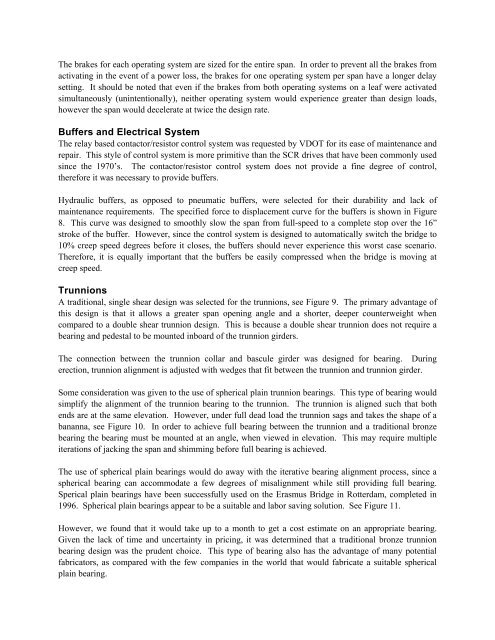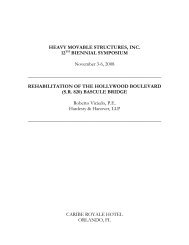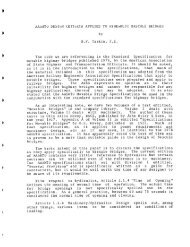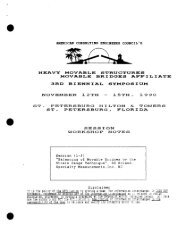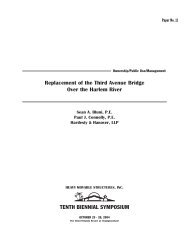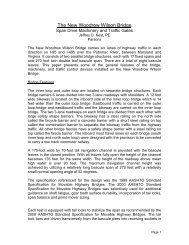Route 33 Over Pamunkey River, West Point, VA - Heavy Movable ...
Route 33 Over Pamunkey River, West Point, VA - Heavy Movable ...
Route 33 Over Pamunkey River, West Point, VA - Heavy Movable ...
- No tags were found...
Create successful ePaper yourself
Turn your PDF publications into a flip-book with our unique Google optimized e-Paper software.
The brakes for each operating system are sized for the entire span. In order to prevent all the brakes fromactivating in the event of a power loss, the brakes for one operating system per span have a longer delaysetting. It should be noted that even if the brakes from both operating systems on a leaf were activatedsimultaneously (unintentionally), neither operating system would experience greater than design loads,however the span would decelerate at twice the design rate.Buffers and Electrical SystemThe relay based contactor/resistor control system was requested by VDOT for its ease of maintenance andrepair. This style of control system is more primitive than the SCR drives that have been commonly usedsince the 1970’s. The contactor/resistor control system does not provide a fine degree of control,therefore it was necessary to provide buffers.Hydraulic buffers, as opposed to pneumatic buffers, were selected for their durability and lack ofmaintenance requirements. The specified force to displacement curve for the buffers is shown in Figure8. This curve was designed to smoothly slow the span from full-speed to a complete stop over the 16”stroke of the buffer. However, since the control system is designed to automatically switch the bridge to10% creep speed degrees before it closes, the buffers should never experience this worst case scenario.Therefore, it is equally important that the buffers be easily compressed when the bridge is moving atcreep speed.TrunnionsA traditional, single shear design was selected for the trunnions, see Figure 9. The primary advantage ofthis design is that it allows a greater span opening angle and a shorter, deeper counterweight whencompared to a double shear trunnion design. This is because a double shear trunnion does not require abearing and pedestal to be mounted inboard of the trunnion girders.The connection between the trunnion collar and bascule girder was designed for bearing. Duringerection, trunnion alignment is adjusted with wedges that fit between the trunnion and trunnion girder.Some consideration was given to the use of spherical plain trunnion bearings. This type of bearing wouldsimplify the alignment of the trunnion bearing to the trunnion. The trunnion is aligned such that bothends are at the same elevation. However, under full dead load the trunnion sags and takes the shape of abananna, see Figure 10. In order to achieve full bearing between the trunnion and a traditional bronzebearing the bearing must be mounted at an angle, when viewed in elevation. This may require multipleiterations of jacking the span and shimming before full bearing is achieved.The use of spherical plain bearings would do away with the iterative bearing alignment process, since aspherical bearing can accommodate a few degrees of misalignment while still providing full bearing.Sperical plain bearings have been successfully used on the Erasmus Bridge in Rotterdam, completed in1996. Spherical plain bearings appear to be a suitable and labor saving solution. See Figure 11.However, we found that it would take up to a month to get a cost estimate on an appropriate bearing.Given the lack of time and uncertainty in pricing, it was determined that a traditional bronze trunnionbearing design was the prudent choice. This type of bearing also has the advantage of many potentialfabricators, as compared with the few companies in the world that would fabricate a suitable sphericalplain bearing.


